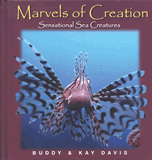The lion fish is a member of the scorpion fish family and is often called turkey fish, zebra fish, dragon fish, butterfly cod, or fire fish. All of the above names refer to its colorful, bold, body stripes and its venomous fins.
Lion fish have a large head with eyes that sit up high and a wide mouth. The fins are long, flowing ribbons, with the pectoral fins being longer than the body. Along with the pectoral fins, the anal fins, dorsal fins, and pelvic fins all have poisonous spines.
When frightened or alarmed, the lion fish will erect the fins and jab toward the suspected predator. If the spine penetrates the flesh, the victim receives venom from the spine. It is not fatal but very painful. There can be burning, swelling, and redness at the site of the sting. The pain will usually subside after two or three hours depending upon the amount of venom injected into the flesh.
Lion fish are found in the Indo-Pacific Ocean and the Red Sea. They can be found at various depths with the more colorful fish in the shallow waters. They like to hide around caves and rock ledges. The lion fish only uses the venom for defense and do not use it for catching their prey. They feed on small shrimp, prawns, and fish that are small enough to swallow whole.
Lion fish give birth to live young with the eggs hatching inside the female’s body. It is reported that they give birth to thousands of young.
In spite of the poisonous spines, you can eat the lion fish but there is not much to eat. They are not fished commercially.
Lion Fish
Scorpaeniformes • Scorpaenidae
Pterois Volitans
Length: 10 inches to over one foot (25–31 cm)
Special Design Feature: The lion fish is very
beautiful with long, flowing fins and showy,
colorful stripes. This colorful fish carries poison
in spines located along the fins.
Did You Know? The poison from the lion fish is
not fatal but is very painful, lasting two to three
hours.

Marvels of Creation: Sensational Sea Creatures
Brings the world of the sea alive in a unique and colorful way with photographs, a page of facts and commentaries.
Browse Kids BookRecommended Resources
- © 2025 Answers in Genesis
- Privacy Policy
- Contact
- About


